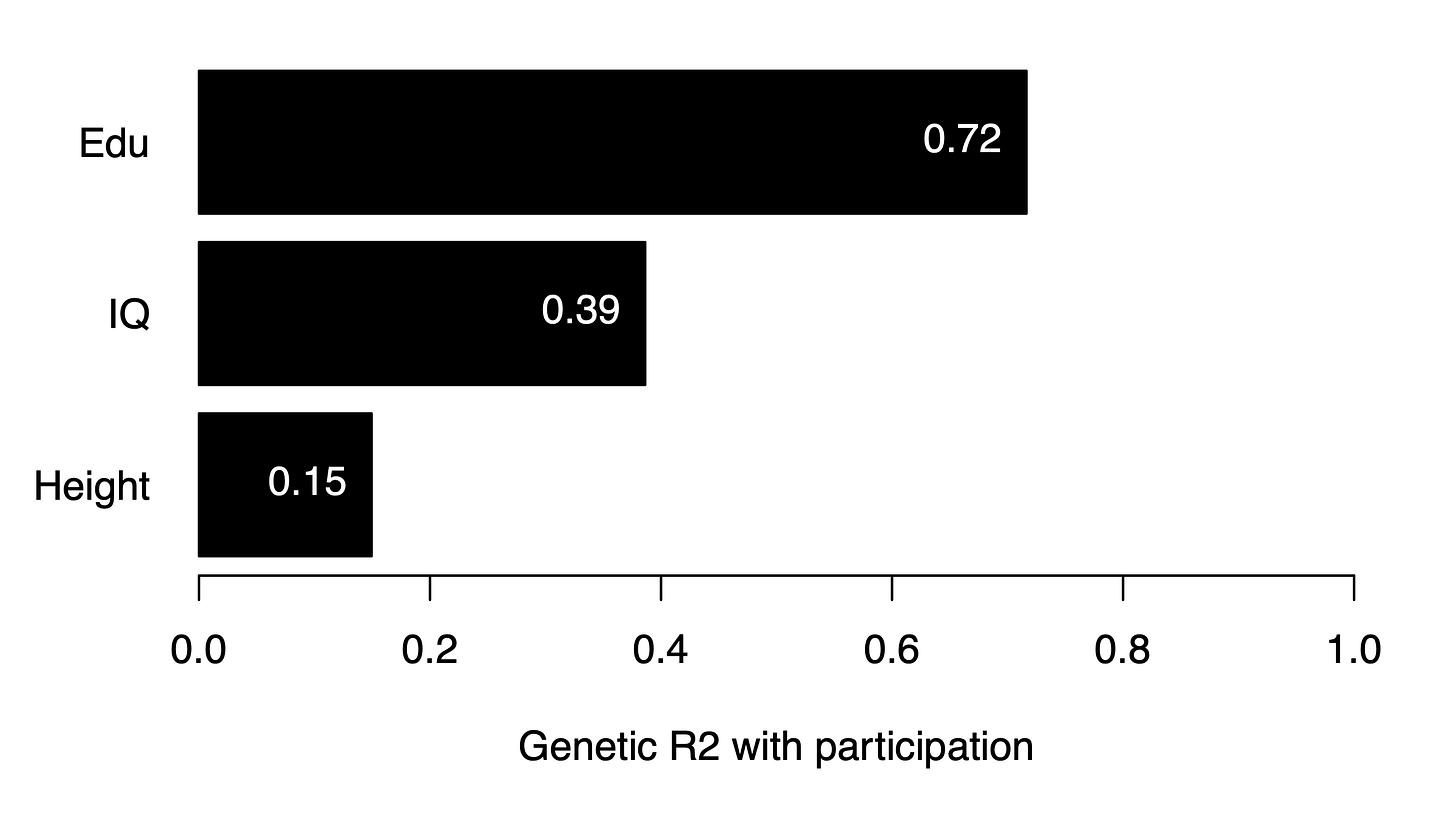No, intelligence is not like height
... and the reason is one of the most interesting findings from modern behavioral genetics
[Update: This post generated a lot of interesting discussion and I responded to some of the comments/questions in a follow-up]
A recent article in The Atlantic discussed the resurgence of race science and, like clockwork, drew indignation from the race “scientists” and their online fanbase (I won’t bother linking because the indignation is always the same: Galileo vs. Lysenko, “evolution doesn’t stop at the neck”, etc). A big component of the race science movement is pseudo-intellectual “debunkings” of mainstream reporting and in this case the focus was on the claim in the article that intelligence is not like height:
Genetics may play some role in the average height in these two countries, but intelligence is not like height. As three prominent psychologists have written, “Modern DNA science has found hundreds of genetic variants that each have a very, very tiny association with intelligence, but even if you add them all together they predict only a small fraction of someone’s IQ score.”
The pushback caught me eye because it mirrored takes I had seen in the past from more credible sources. For example, when the genomic testing company Nucleus Genomics argued for the validity of their IQ predictor, the title of their article was “Genetics can predict height, cancer risks, neuropsychiatric diseases and more — but not IQ?” (I’ve written previously why I think this product is snake oil). In fact, for a long time many geneticists (myself included) did assume that we could treat cognitive phenotypes like IQ or educational attainment as if they were any other trait. Plug IQ scores and genetic data into an association analysis, control for relatedness and ancestry with fancy methods, and out come significant genetic associations that replicate in external cohorts.
But over the past five years it has become clear that IQ and educational attainment are not like height in fundamental and meaningful ways, and the reason behind this difference is one of the most important and interesting results to come out of modern behavioral genetics. So let’s go through it piece by piece.
IQ is much less heritable and more confounded than height
We’ll start with the specific point made in The Atlantic article (and the Vox article that it is citing) that, unlike height, adding up all of the genetic variants only predicts a small fraction of IQ score. This is just objectively true: the largest genetic analysis of IQ scores built a predictor that had an accuracy of 2-5% in Europeans, depending on the target cohort [Savage et al. (2018) - Table S9] whereas the largest genetic analysis of height build a predictor that had an accuracy of 45% in Europeans [Yengo et al. (2022) - Figure 4A]. I’m quite certain that 45% is larger than 5% though perhaps the race scientists will come up with some new math to debunk this.
So this claim is true as of the best available studies today. But prediction accuracy depends on sample size, could the findings drastically change with more samples in the future? In fact, through the magic of statistics, we actually know that this claim will always to be true. We know this because we have estimated a parameter called molecular heritability, which tells us the upper bound on what a genetic predictor could ever achieve1. Molecular heritability comes in two forms. “Population heritability” is a non-causal measure of the overall correlation between all genotyped variants and the trait, and it is estimated in large populations of unrelated individuals. Population heritability includes direct genetic influences on the trait that we typically think of as “genetics” but it also includes a lot of other correlated stuff that we typically think of as confounding, like cultural influences on the trait from relatives or prior generations (including the effects of parenting or dynastic advantages) or biases due to population stratification. In contrast, “direct heritability” is a measure of the specific genetic influences that are acting within individuals, and it is estimated in a large number of families. Direct heritability is immune to many sources of environmental confounding and, with some assumptions, can be interpreted as an estimate of causal genetic effects (for theory and derivations see [Veller et al. (2023)])2.
Fortunately for us, both the population heritability and the direct heritability were recently estimated for height, educational attainment, and IQ in a massive study of siblings by Howe et al. (2022). As expected, they find that the population heritability for height (37%) is much higher than for IQ (23%) or for educational attainment (12%). This was not particularly surprising as these estimates have been known from prior studies, but it underscores the point made by The Atlantic article: genetic prediction of height will always be much more accurate than that of IQ or educational attainment. What was surprising was the novel estimate of direct heritability. For height, 38% and statistically indistinguishable from the population estimate3. But for IQ, the direct heritability dropped to 15% (with a wide error bar) and for educational attainment all the way down to 4% (with a narrow error bar). These substantial decreases are the result of some mix of cultural influences, assortative mating, and population structure4.

So not only is IQ/education less heritable than height in the non-causal population sense, it is also more saturated with environmental confounding and stratification than height (this shouldn’t be too surprising, since it is much more difficult to parent your kids into being taller than into being better at tests). After confounding is removed within families to derive an approximately causal estimate, the gap between IQ/education and height grows even further. For educational attainment — the one objectively measurable cognitive outcome we can actually interpret — the causal contribution of genetics is a piddling 4%.
Genetic effects on IQ differ within families much more than for height
In addition to looking at the total magnitude of the genetic contribution, we can also compare the effects/associations of individual variants estimated in the population and the direct/within-family study. This is called the “genetic correlation”, and it quantifies the extent to which the two sets of effects are similar (after accounting for estimation noise). Even if the population-level estimates are distorted by some simple confounding (for example, parental influences) we might still expect that the genetic effects learned in the population closely mirror the direct effects and for the genetic correlation between the two to be close to 1.
Recently, Young et al. (2022) quantified this genetic correlation between population and within-family/direct effects in a similar cohort to the one used above. As expected, for height the squared correlation was 0.96, meaning that the two estimates were essentially identical — you can think of this as saying that the genetic associations estimated in the population (i.e. between families) are a pretty good proxy for the genetic influences within families, “explaining” 96% of them. In contrast, for IQ the squared correlation was 0.24 and for educational attainment 0.55 (both very significantly lower than 1). This means the genetic associations observed in the population are mostly not the same as the causal effects observed in families. These differences are shockingly large, four other traits besides height were tested in Young et al. and all produced correlations that were indistinguishable from 1.0.

For context, the squared genetic correlation between depression and schizophrenia is estimated at 0.26 [Bulik-Sullivan et al. (2015)]; meaning the genetic correlates of IQ in the population and in families are more different than those of two completely different psychiatric traits! The reason for these differences is still mostly unknown. Young et al. showed that some of the bias is due to population stratification, whereby the population effects are picking up correlations with where people tend to live and the environments therein5 and hypothesized that study participation bias may also be at play (see next section). In other words, what was initially thought to be caused by genetics turned out (to some extent) to be caused by zipcodes.
IQ estimates are much more biased by participation than height
Another emerging source of bias is the act of participating in a genetic study itself. We sometimes forget this point, but people have to jump through hoops to end up in a genetic analysis: they need to know about the study and be able to access it (which typically means living near a major hospital or university and having the resources to engage with it), provide informed consent, fill out the relevant questionnaires, etc. Each of these steps will ascertain for a certain subset of individuals, and unsurprisingly that type tends to be highly educated and do relatively well on IQ tests. Recently, [Schoeler et al. (2023)] estimated a participation “liability” for each individual in a biobank (i.e. how likely they were to be biobank participants relative to the general population) and then ran a genetic association study on this liability as if if it were a phenotype. The trait with the largest genetic correlation between the participation phenotype was educational attainment (r² = 0.72) with IQ not far behind (r² = 0.39). Height, on the other hand, had a significant but modest r² = 0.15; presumably through correlations with socioeconomic status (for example, influencing participation through healthcare access and height through nutrition).

Yet again, education and IQ were meaningfully different from height: much more closely linked to the genetic mechanisms that drive people to participate in studies. The resulting ascertainment bias means that current genetic analyses are over-trained on a specific subset of participants, and this likely has other distorting effects on the inferred relationships between education/IQ and other traits.
The genetics of IQ is much more environmentally sensitive than height
So far we have mostly treated these phenotypes as if they exist within a homogenous environment, but of course education/IQ are both influenced by and causes of environmental differences, which will in turn shape their apparent correlation with genetics. To explore the interaction of cognitive phenotypes with environment [Mostafavi, Harpak et al. (2020)] and [Rask-Andersen et al. (2021)] divided individuals into groups based on measures of socioeconomic status and re-estimated the (population-level) heritability in each group. Strikingly, the heritability was significantly lower in the high SES versus low SES populations: 0.13 versus 0.26 for education and 0.22 versus 0.31 for IQ scores6. Again, these differences are not trivial, the association between genetics and educational attainment is twice as high in deprived environments as it is in wealthy environments.

What about height? Prior work from [Ge et al. (2017)] looked at the relationship between heritability and SES across a large number of traits and found no significant difference for height (while recapitulating the significant environmental interaction for educational attainment). In other words, the genetic associations with IQ/education are substantially different in magnitude in different environments (this is known as GxE “amplification”, which I have discussed in more detail in the past). The genetic associations with height (you guessed it) are not.
Unlike height, no one knows what IQ is actually measuring
I’ve so far avoided the question of what IQ scores are actually measuring and just treated them like a black box. But the contrast with height in terms of construct validity is worth mentioning. Height is a property of the body, and researchers use a ruler as the instrument of measurement. Intelligence is (presumably) a property of the mind, and researchers use IQ tests as the instrument of measurement. The mechanism by which a ruler measures height is completely understood; different rulers, even those constructed centuries apart, get consistent estimates; as do other measuring devices. In contrast, the mechanism by which an IQ score measures intelligence is not understood at all. Different tests can get substantially different estimates and need to be normalized against some population. The estimates across populations change dramatically with each generation, as does the structure of the subtests that comprise the IQ test (see [Nisbett et al. (2012)]). As a consequence, IQ tests regularly become obsolete and need to be perpetually revised or re-normed (see [Flynn (2009)] for literal life and death consequences of test norms). Unlike height, the thing the IQ score is measuring is unseen; it could be a single mechanism like processing speed, or it could be samples from thousands of different processes, or the emergent property of a complex interactive network. No one knows for sure and the debate has been going on for over a century (see [Clapp Sullivan et al. (2024)] for the most recent perspective).
Beyond IQ scores, there is also the transformation of those scores into g or the “general factor of intelligence”. Since researchers do not know which ruler to use to measure intelligence, they will often collect IQ scores from many different rulers/tests and then use statistical modeling to extract a common factor that captures variation across individuals. Unlike height, which exists for any one individual and would exist even if there were no rulers to measure it, this extracted g factor can only be defined for a population (“unlike such modules as the heart … g is not a hypothesized mechanism within persons but a variable that ranges over persons” ~ [Boorsbom and Dolan (2006)]). A population of one individual can still be 6 feet tall, but a population of one individual has no g. This leads to all sorts of confusion as the concepts of intelligence, g, IQ, and IQ scores are used interchangeably in the literature (for example: an important study by Ritchie et al. 2018 argued that “education improves intelligence” while Ritchie et al. 2015 — the same lead author — argued that education does not improve “general cognitive ability” in the title, and then “general intellectual capacity” in the abstract). Science writers attempting to communicate to the public must then navigate a minefield of terminology akin to the now cliche misuse of “Assault Rifle” in the coverage of mass shootings. Use the term “IQ” when you are actually talking about “intelligence” — concepts most lay readers treat as indistinguishable — and you’ll get a demerit in the intelligence discourse; use the terms precisely and you’ll confuse most of your readers. The bottom line is, while there are many measured IQ scores in different settings, and those scores are often transformed into g factors from a myriad of factor models, there is zero consensus on how these scores or factors map to actual intelligence - the thing we have yet to observe or agree on a model of. Nor, as we saw above, how they map to causal genetic effects.
Ways in which height and IQ are alike
With all of that said, it is worth keeping in mind the ways in which height and IQ are similar:
Like most common traits, IQ/educational attainment and height are all influenced by genetics to some extent. In fact, it is almost impossible to find a human trait that does not have some genetic contribution, which is why the field focuses on quantifiable parameters rather than just a “heritable” versus “not heritable” dichotomy. If this is a hard pill to swallow, just think about any number of well-established genetic conditions in children: such conditions will undoubtedly make it difficult to attend school and limit educational attainment, thus generating an association with genetics.
IQ/education and height are all highly polygenic, meaning they are influenced by a large number of variants. For example, 12,111 independent variants explain most of the common variant heritability of height [Yengo et al. (2022)] and 3,952 independent variants have already been identified as associated with educational attainment [Okbay et al. (2022)].
IQ/education and height are all changing substantially over time. I’ve already mentioned the dramatic increase in IQ known as the Flynn Effect and the increase in college attendance is well known. But height has also increased in many places (for example a ~3 inch gain in height in Japan in 50 years). Heritability is a measure of variation in the present environment and does not dictate what happens to the mean of a trait either presently or over time. So even highly heritable traits like height have changed substantially within a short time-frame.
IQ/eduction and height are all under fairly substantial assortative mating, with mate-pair correlations of 0.23, 0.48, and 0.27 respectively [Horwitz et al. (2023)]. These correlations can distort various genetic estimates and require careful adjustment, especially for traits with high heritability (for example, the population heritability of height can be slightly inflated by assortative mating, whereas the direct heritability can be slightly deflated). However, it is the combination of assortative mating and cultural/dynastic transmission, largely unique to IQ/education, that wreaks havoc on genetic analyses.
The ubiquity of moderate genetic influences on nearly all common traits is worth keeping in mind so that we do not overreach and start misinterpreting genetic confounding for environmental influence.
Why it is important
I mentioned that the difference between IQ and height is one of the most interesting findings in modern behavioral genetics and I do think that is true. Though we’ve known theoretically that the causal arrow between genes and culture could go both ways, these new molecular findings are a clear demonstration of cultural forces shaping and mimicking genetic processes — and the lack of similar forces on height serves as an important negative control. In the context of population differences — a focus of the piece in The Atlantic — direct/within-family heritability provides an upper bound on how much a trait can drift between populations under neutrality (see [Edge and Rosenberg (2015)] and summary). For educational attainment, for example, we can already calculate that the expected variance between continental populations under neutrality is minuscule: heritability*Fst = 0.04*0.15 = 0.006. But if we do ever disentangle the direct and indirect components, they could be leveraged to estimate cross-generational influences that are otherwise very difficult to observe. Scientists enjoy a challenge and the study of a complex, stratified, environmentally sensitive process without construct validity is a veritable feast of challenges.
But we should not lose sight of the fact that understanding intelligence is a major challenge. Within the field of behavioral genetics, experts will write a detailed and informative technical explanation of the many sources of confounding mentioned above7 aimed at other academics, and then some of those same experts will argue that sources of confounding “have substantially been addressed” aimed at the public. Within the field of intelligence research itself, the acknowledgement of confounding barely even happens. Heritability is wielded to provide IQ scores with a gloss of biological credibility and paper over the issues of interpretation described above. Mainstream textbooks present molecular findings in highly simplistic terms while otherwise steering far clear of gene-environment confounding (or denying it even exists). Nearly a decade of genetic studies of cognitive outcomes were done under the assumption that the effects being identified were direct when that was largely not the case. Prior to that, over a century of race science argued that intelligence is just like any other biological trait, with individual differences explained by simple genetic causes that are easily quantifiable and culturally immutable. It turns out molecular genetics has (for lack of a better word) thoroughly debunked that view. But when this cold fact is pointed out the response is to simply deny it ever happened.
Also see this follow-up post responding to some comments and questions:
“The GREML estimate directly quantifies the proportion of phenotypic variance explained by all SNPs used in GWAS and therefore provides the upper limit of [heritability of genome-wide significant SNPs] given the same experimental design.” ~ [Yang et al. (2017)]
It is important to keep in mind that direct genetic effects can still be mediated by processes we would consider purely environmental. For example, a society where individuals with certain color skin are forbidden from attending school will have a high direct heritability of educational attainment because skin color is highly heritable — even though the process mediating this heritability is entirely socially constructed. Heritability need not imply biology.
All heritability estimates presented here were corrected for assortative mating as derived in [Kemper et al. (2021)] and [Border et al. (2022)] (see summary here). Mate-pair correlations were taken from the UK Biobank analysis in [Horwitz et al. (2023)].
Lest you think these are simply genetic effects acting directly in parents — so-called “genetic nurture” — recent work by [Nivard et al. (2024)] using extended families showed this too is an oversimplification: “We found that indirect genetic effects on children's academic achievement cannot be explained by processes that operate exclusively within the nuclear family.”
“We examined the degree to which GWAS estimates reflect direct effects by estimating the genome-wide correlation between direct and population effects, finding that population effects and direct effects are not highly correlated (<0.9) for EA and cognitive ability. We found evidence that this is in part due to recent structure in the population that is captured by PCs of the IBD relatedness matrix, but not by PCs computed from common variants. Our simulation results (Supplementary Table 2) suggest that a combination of vertical transmission and AM may also contribute to the low correlation between direct and population effects.” ~ Young et al. (2022)
Direct/within-family heritabilities were not estimated in these studies, so these population-level estimates will include sources of confounding as previously mentioned.
On confounding in educational attainment versus height: “For example, Lee et al.’s (2018) population-based GWAS of educational attainment reported a follow-up analysis of 22,135 sibling pairs that found within-family associations were deflated by ∼ 40%. They found that assortative mating could explain at most one third of the observed deflation, with most remaining deflation likely explained by omitted-variable biases (from nongenetic omitted factors) in the original GWAS. For comparison, they conducted an analogous analysis of height, finding more modest deflation, all of which could plausibly be attributed to assortative mating (See also the follow-up analyses in Okbay et al., 2022).”
On assortative mating: “if the phenotype (or a correlated phenotype) is subject to assortative mating, the controls are unlikely to adequately address confounding from the LD that is due to assortative mating, including cross-chromosome LD”
On population stratification: “When imperfect controls (such as genetic PCs) are used, genetic studies do not have a clean causal interpretation and should instead be interpreted through a predictive framework.”






Really glad to see you cite Borsboom.
As Borsboom notes, intelligence and height are pretty different. Intelligence is measured and defined as a between subjects latent variable. Height, on the other hand, is not defined as in terms of between subject differences, but in terms of an empirical concatenation operation.
They are pretty clearly different! It is crazy to see many prominent intelligence researchers think this is even remotely controversial. A lot of them have convinced themselves that any sort of criticism of intelligence research is ideologically motivated or something, which is pretty unfortunate.
I am really glad that you are popularizing the criticisms of hereditarian/race science research that have always been met with vitriol and negativity by those specific communities so it has been hard to actually openly argue about them. You are really doing a great public service.
It's not nature vs nurture. You nurture nature.